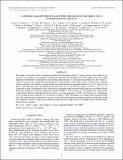A STRONGLY MAGNETIZED PULSAR WITHIN THE GRASP OF THE MILKY WAY'S SUPERMASSIVE BLACK HOLE
Author(s)
Rea, N.; Esposito, P.; Pons, J. A.; Turolla, R.; Torres, D. F.; Israel, G. L.; Possenti, A.; Burgay, M.; Papitto, A.; Perna, R.; Stella, L.; Ponti, G.; Haggard, D.; Camero-Arranz, A.; Zane, S.; Minter, A.; Mereghetti, S.; Tiengo, A.; Feroci, M.; Mignani, R.; Vigano, D.; Schodel, R.; Gotz, D.; Baganoff, Frederick K; ... Show more Show less
DownloadRea-2013-A STRONGLY MAGNETIZE.pdf (979.5Kb)
PUBLISHER_POLICY
Publisher Policy
Article is made available in accordance with the publisher's policy and may be subject to US copyright law. Please refer to the publisher's site for terms of use.
Terms of use
Metadata
Show full item recordAbstract
The center of our Galaxy hosts a supermassive black hole, Sagittarius (Sgr) A*. Young, massive stars within 0.5 pc of Sgr A* are evidence of an episode of intense star formation near the black hole a few million years ago, which might have left behind a young neutron star traveling deep into Sgr A*'s gravitational potential. On 2013 April 25, a short X-ray burst was observed from the direction of the Galactic center. With a series of observations with the Chandra and the Swift satellites, we pinpoint the associated magnetar at an angular distance of 2.4 ± 0.3 arcsec from Sgr A*, and refine the source spin period and its derivative (P = 3.7635537(2) s and [dot over P] = 6.61(4) x 10[superscript -12 s s–1)], confirmed by quasi simultaneous radio observations performed with the Green Bank Telescope and Parkes Radio Telescope, which also constrain a dispersion measure of DM = 1750 ± 50 pc cm[superscript –3], the highest ever observed for a radio pulsar. We have found that this X-ray source is a young magnetar at ≈0.07-2 pc from Sgr A*. Simulations of its possible motion around Sgr A* show that it is likely (~90% probability) in a bound orbit around the black hole. The radiation front produced by the past activity from the magnetar passing through the molecular clouds surrounding the Galactic center region might be responsible for a large fraction of the light echoes observed in the Fe fluorescence features.
Date issued
2013-09Department
MIT Kavli Institute for Astrophysics and Space ResearchJournal
The Astrophysical Journal. Letters
Publisher
IOP Publishing
Citation
Rea, N., P. Esposito, J. A. Pons, R. Turolla, D. F. Torres, G. L. Israel, A. Possenti, et al. “A STRONGLY MAGNETIZED PULSAR WITHIN THE GRASP OF THE MILKY WAY’S SUPERMASSIVE BLACK HOLE.” The Astrophysical Journal 775, no. 2 (September 11, 2013): L34. © 2013 The American Astronomical Society
Version: Final published version
ISSN
2041-8205
2041-8213